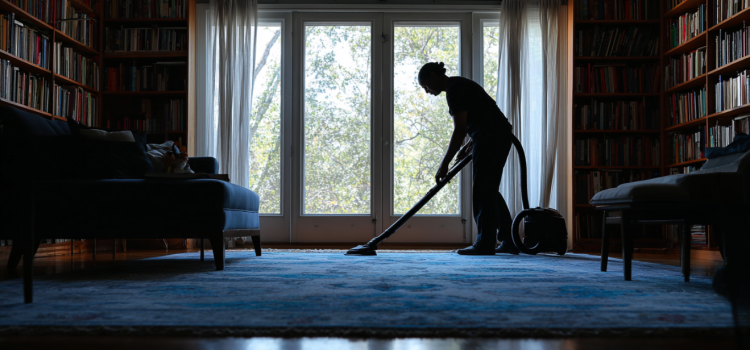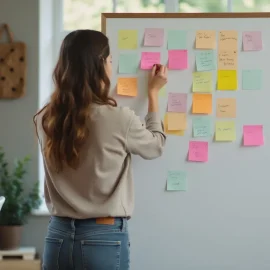
Do you struggle to stay disciplined in work and life? Should you be focusing more on short-term or long-term values?
In the book How to Do Things You Hate, Peter Hollins explains that avoiding doing the things you don’t want to do creates a spiral that makes everything worse. Instead, he teaches you how to strengthen your self-discipline so you can find the motivation to get things done.
Continue reading for an overview of Hollins’ book, complete with exercises.
Overview of How to Do Things You Hate
Want to escape the cycle of struggling through work, watching your to-do list endlessly expand, and doubting you’ll ever succeed? It’s easier to do than you might think—and in How to Do Things You Hate, Peter Hollins explains that self-discipline is hard but simple: You just need to stop avoiding discomfort. By instead facing it, you can master your mind, stop avoiding what you know you need to do, and begin taking consistent, disciplined action that serves your highest values.
Hollins is an author and a self-described “student of the human condition” who’s written numerous books on learning, self-mastery, peak performance, and more. He can be found on his website.
We’ve reorganized the book’s ideas into three parts:
- The Problem: Avoiding Discomfort—how running from discomfort causes you to spiral downward in a vicious cycle of avoidance and frustration.
- The Solution: Working With Discomfort—how to instead face discomfort, master your thoughts and feelings, and move in the direction of your values.
- Staying Disciplined for Good—how to focus, work with your natural energy cycles, and show up every day no matter what.
The Problem: Avoiding Discomfort
We’ll look in this section at Hollins’s core insight about doing the hard things: Namely, that when you need to do something hard, avoiding it due to discomfort only delays and worsens the difficulty. We’ll explore this way of avoiding discomfort and the downward spiral it creates, as well as how it manifests in each of us differently.
Avoiding Your Experience
According to Hollins, we too often avoid doing hard things because we’re unwilling to face the discomfort involved. We’ll call this discomfort avoidance. It’s when you go out of your way to avoid experiencing unpleasant thoughts and feelings, which are often associated with some hard thing you have to do. You tend to rationalize this behavior by convincing yourself you need to be in the right mood to do the hard thing. You also think you’ll feel more up to the task in the near future (you won’t, Hollins says—this is a fallacy).
The problem is that when you need to get something done, avoiding it doesn’t make it go away—it just worsens the bad feelings associated with what you’re putting off. It also wastes your time. For instance, say you have an important document to prepare for an approaching deadline, but you don’t feel like getting started. You tell yourself you’ll get to it later and check your phone instead, then before you know it an hour has passed and you’ve started feeling guilty.
Avoidance Spirals Downward
Once you’ve started feeling worse and wasting time, you’re even more likely to keep avoiding that hard thing. Hollins writes that this kicks off a downward spiral that only delays the work (because you can’t put it off forever) and worsens the discomfort associated with it.
Continuing the earlier example: Once you’ve begun feeling guilty for checking your phone instead of doing your work, you feel even less in the mood to start. You tell yourself it can wait—you have a few days left—and fiddle away with less important admin tasks. But you feel the work hanging over your head, and your anxiety about it grows. By the end of the day, you’re beating yourself up about wasting time, and when tomorrow comes around, you just think you’ll be in a better mood to start later.
According to Hollins, you’ll never be in the right mood later. The only thing to do is to get started right now, in the present moment, by facing your discomfort. We’ll explain how later in the guide.
Recognize Your Unique Spiral
While we all avoid discomfort, Hollins points out that each of us does it a little differently. The specific kind of discomfort that triggers you to start avoiding something hard, and the particular series of behaviors you spiral through, will be unique to you.
Hollins describes four triggers that can start an avoidance spiral. Each trigger can spiral into feelings like anxiety, shame, or guilt, and behaviors like ignoring the task, busying yourself elsewhere, or entertaining yourself instead of working. As you read through them, notice which ones feel familiar—most of us recognize ourselves in more than one.
- You feel overwhelmed or confused. Maybe your priorities aren’t clear, so you don’t know where to start. This uncertainty can lead to decision paralysis, and before you know it, you’re scrolling on your phone instead of figuring out what to do first.
- You feel afraid of something about the task. This could be fear of failure and the judgment that would bring. Or, counterintuitively, it could be fear of success—if you do well, people might expect even more from you next time.
- You feel tired or depleted. Sometimes this is genuine exhaustion because you’re actually burned out. Other times, you might be working against your natural energy cycles, or you’ve gotten into the habit of telling yourself “I’m too tired” so often that you start to believe it.
- You prefer the easy thing over the hard thing. This is what Hollins calls simple laziness—when you know what you need to do, and you’re capable of doing it, but you’d rather grab a bite to eat or check social media than tackle something that requires effort.
The Solution: Embracing Discomfort
So far, we’ve seen how avoiding hard things creates a downward spiral that delays and worsens the discomfort associated with the work you need to do. In this section, we’ll explore the solution to this problem: embracing discomfort. According to Hollins, this involves changing how you view discomfort and learning to move directly into it.
Change How You View Discomfort
Hollins says that the difference between disciplined and undisciplined people isn’t what they do, but how they think. In other words, mindset makes more of a difference than method. To that end, he recommends that you shift your mindset to incorporate the following three views.
View #1: Discomfort Is Your Ally, Not Your Enemy
Recognize that discomfort is the source of all growth—you can’t grow without pushing at your edges. Meanwhile, comfort tends to make us stagnate. The more comfortable you get, the less you can tolerate the discomfort that accompanies hard efforts.
For these reasons, discomfort is something to embrace, not avoid. Hollins recommends that you actively seek out discomfort, saying that this will help you build resilience and resourcefulness. He recommends undertaking a misogi (a Japanese tradition of going on challenging expeditions in the natural world).
View #2: Long-term Values Matter More Than Short-term Comforts
Hollins explains that to get anywhere in life, you have to regularly act in alignment with clear, consistent values. If you too often put temporary, immediate comforts over discomforting effort that serves your values, you’ll never succeed.
Hollins recommends clarifying your values by doing the tombstone exercise: Ask yourself what you would want to see written in your obituary or on your tombstone. Then, when things get hard, remind yourself that upholding your values by facing discomfort is more important than comforting yourself.
View #3: Responsibility Trumps Reactivity
According to Hollins, we all have the ability to consciously override our knee-jerk reactions, ride out our emotions, and act more intentionally. Realizing this will help you responsibly face discomfort rather than reactively avoid it.
Hollins explains that in the brain, the neurochemicals that produce emotions break down after 90 seconds. This means that if you’re still feeling those emotions, you’re refreshing them by thinking thoughts associated with them (such as by ruminating on how angry you feel). So when you feel caught up in some emotion, like discomfort, remind yourself: It’s better to ride this out than react unthinkingly.
Bring Awareness to Your Discomfort
Now that we’ve seen how to adopt a mindset that embraces discomfort, let’s look at Hollins’s method. In this section, we’ll cover how to move into and through your discomfort using a mindfulness-based awareness practice and simple action steps.
Hollins writes that by bringing awareness to discomfort, you’ll learn that you can actually feel it without being controlled by it. In turn, you’ll realize that your tolerance for discomfort is higher than you believe, and that you can push at your edges without giving up or falling apart.
Hollins discusses a few distinct frameworks for awareness practice; we’ve distilled them into the below method that preserves the essentials without redundancy. Before beginning, he recommends that you first forgive yourself for spiraling in the first place. Realize that everyone messes up, everyone gets stressed, and everyone has a hard time with hard work. You can and will get through it, but being overly critical of yourself won’t help.
After forgiving yourself, follow these four steps:
- Notice your discomfort: Become aware of the state of mind you’re in. Simply recognize that you’re feeling that way, without judging.
- Own your discomfort: Allow it to be just as it is, without analyzing or pushing it away or otherwise trying to change it.
- Investigate your discomfort: Ask about the possible causes of this state of mind, about what would happen if you act on it, and whether it aligns with your values.
- Release your discomfort: Realize that you aren’t your spiral, whether it involves fear, anxiety, depression, self-critical thoughts, or something else. You’re in a temporary state of mind that isn’t you, per se, and it’ll pass.
Practicing this method, Hollins says, creates a state of inner calm. From there, you can better respond (such as by doing the work even though you don’t want to) rather than simply reacting unthinkingly. Then all you need to do is start, taking one small step—like opening your word processor—to get the ball rolling.
Staying Disciplined for Good
Up to this point, we’ve covered the main problem that prevents us from being more disciplined (avoiding discomfort) and Hollins’s solution for it (working with discomfort). But once you get moving with his main advice, you’ll need a way to keep up your efforts for the long run. We’ll look next to his recommendations for stabilizing and sustaining your newfound discipline by sharpening your focus and using smart productivity strategies.
Stabilizing Your Discipline
It’s all well and good to confront discomfort once or twice, but how do you keep it up over time? Hollins says that to stay disciplined, you need both focused attention and focused commitments. That is, you have to train your mind to concentrate clearly, steadily, and on command; and you have to set your life up to support focused action that serves your values.
Focus Your Attention
To develop your powers of concentration, take up focus-based awareness training. This involves learning to train your attention on a single point of reference, like your breath. Hollins says this will sharpen your mental acuity, giving you greater control over your mind and, therefore, your actions.
You can do this by sitting at rest in a regular chair, bringing your awareness gently to your breath, and practicing maintaining your attention there. You will mess up, early and often. That’s OK—reframe loss of focus as a cue to gently bring your attention back to your breath, and consider that one “rep” of practice (training your attention to focus is like training muscles at the gym).
Hollins adds that beyond directly training your mind to focus,you have to take care of your body, too. Since the mind emerges from the body (he writes that it’s generated by the brain), a well-cared for body will produce a healthy mind.
Care for your body by eating well, getting regular doses of good stress (stress that pushes but doesn’t blow through your limits, like moderate exercise), and getting plenty of good sleep. All of these contribute to healthy maintenance of your energy, motivation, and mental sharpness.
Focus Your Efforts
A focused mind will take you far—but you also need to focus your efforts, according to Hollins. He writes that all highly successful people know they have limited daily energy, so they focus obsessively on the few things that matter most to them. Concentrating their energy like a laser into just one or two efforts, they get more done. In contrast, unsuccessful people scatter their energy around like a weak flashlight, wasting it on unnecessary distractions.
To focus your energy like a laser, let go of everything but your most cherished aspirations. Hollins recommends that you do this by taking stock of what you want to achieve in your life. Write down 25 items, then eliminate all but five. Put the other 20 on an “avoid at all costs” list and don’t do them. For instance, you might want to found a startup, travel the world, marry a good partner, get fit, and learn to surf. You might also want to eat your way through NYC, raise puppies, bike across Asia, plant a garden, and more—but you drop these to focus on the five that matter most to you.
Sustaining Your Discipline
We’ve seen how to focus your mind and your efforts; now, let’s look at how to sustain your discipline for the long haul.
According to Hollins, the key to lasting discipline lies in learning how to persevere through the inevitable trials and travails of life. Self-discipline isn’t a box you can check off a to-do list—it’s a lifelong effort. You’ll never always feel perfectly competent, perfectly motivated, or perfectly inspired. Life will get unexpectedly hard at times, and your drive will fluctuate. This is all normal.
In fact, most of the disciplined life involves toiling for long periods of time without much in the way of a reward. Progress and success come intermittently, Hollins says, so you’ll have to sustain yourself through these plateaus. He offers three strategies for doing this, which we’ll look at below.
Work With Your Body
First, Hollins recommends that you learn to work with your body’s natural cycles. He explains that within the more familiar circadian rhythm (your body’s sleep and wakefulness cycle), we also have ultradian rhythms. These are shorter, 90- to 120-minute cycles in which our energy rises to a peak, then falls to a floor. You perform best when your energy is rising and peaking, and you perform worst when your energy is falling and flooring.
To take advantage of these cycles, observe your energy levels for a week and take note of when you feel awake and alert versus tired and sluggish. Then, schedule your toughest tasks—like complex work or hard exercise—to coincide with your rises and peaks. Likewise, schedule breaks for your falls and floors.
Learn to Shift Your State
Even if you work with your ultradian rhythms, Hollins says, you’ll sometimes feel unmotivated anyway (which is normal). To handle this, develop a startup routine. This is a set sequence of actions you take to change your state from unmotivated to motivated, and it’ll enable you to get ready and going no matter what.
Begin your routine with a single easy step, like washing your face. Let that easy step cue you into some form of movement, like taking a brisk walk or stretching. The movement is what gives you energy and motivates you. Practice this sequence consistently until it becomes second nature. Then when you need to change your state, you can just take the first action and let the rest unfold.
Never Give Zero Effort
If working with your rhythms and using a startup routine both fail you, Hollins has one more piece of advice: Never give zero effort. As long as you do your best to do the bare minimum every day, you won’t lose your discipline. Even if that best fluctuates wildly, you can rest easy knowing you did something—and that you haven’t given up on trying. And that’s all you really need to do, day in and day out, to succeed.
Exercise: Never-Zero Discomfort Practice
Think of something you’ve been avoiding, like a difficult conversation, a challenging project, a health habit you know you should start. Instead of waiting until you feel “ready,” commit to facing this discomfort in small doses every single day for the next two weeks, using Hollins’s method.
- What specific thing have you been avoiding that you know would improve your life if you addressed it? For instance, maybe you’ve been meaning to start stretching.
- What’s the smallest possible step you could take toward this thing every day? If it’s stretching, you might practice bending forward; or if it’s a work project, you might spend at least five minutes working on it. Commit to taking this minimum action daily for the next 14 days.
- When you notice discomfort arising, you’ll need to practice Hollins’s method: Notice the feeling without judgment, accept it rather than pushing it away, investigate what’s driving it, and disidentify from it (remember, you’re not your temporary discomfort). What will you do to remind yourself of this method?
- After completing your small action each day, how will you acknowledge that you kept your never-zero commitment, even if you didn’t feel like it? For instance, you might mark a tally for the day on your calendar.






